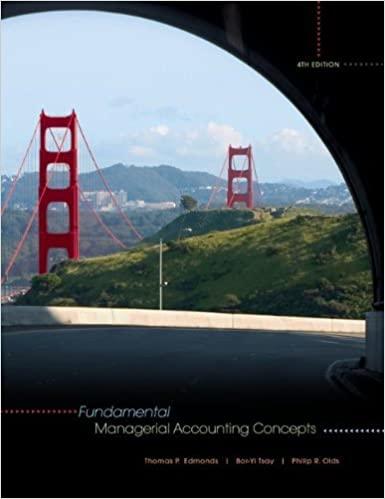Key activity-based costing concepts Agee Paint Company makes paint in many different colors; it charges the same
Question:
Key activity-based costing concepts Agee Paint Company makes paint in many different colors; it charges the same price for all of its paint regardless of the color. Recently, Agee’s chief competitor cut the price of its white paint, which normally outsells any other color by a margin of 4 to 1. Agee’s marketing manager requested permission to match the competitor’s price. When Gene Taylor, Agee’s president, discussed the matter with Kay Spencer, the chief accountant, he was told that the competitor’s price was below Agee’s cost. Mr. Taylor responded, “If that’s the case, then there is something wrong with our accounting system. I know the competition wouldn’t sell below cost. Prepare a report showing me how you determine our paint cost and get back to me as soon as possible.”
The next day, Ms. Spencer returned to Mr. Taylor’s office and began by saying, “Determining the cost per gallon is a pretty simple computation. It includes $1.10 of labor, $3.10 of materials, and $4.00 of overhead for a total cost of $8.20 per gallon. The problem is that the competition is selling the stuff for $7.99 per gallon. They’ve got to be losing money.”
Mr. Taylor then asked Ms. Spencer how she determined the overhead cost. She replied, “We take total overhead cost and divide it by total labor hours and then assign it to the products based on the direct labor hours required to make the paint.” Mr. Taylor then asked what kinds of costs are included in the total overhead cost. Ms. Spencer said, “It includes the depreciation on the building and equipment, the cost of utilities, supervisory salaries, interest. Just how detailed do you want me to go with this list?”
Mr. Taylor responded, “Keep going, I’ll tell you when I’ve heard enough.”
Ms. Spencer continued, “There is the cost of setups. Every time a color is changed, the machines have to be cleaned, the color release valves reset, a trial batch prepared, and color quality tested. Sometimes mistakes occur and the machines must be reset. In addition, purchasing and handling the color ingredients must be accounted for as well as adjustments in the packaging department to change the paint cans and to mark the boxes to show the color change. Then . . . ”
Mr. Taylor interrupted, “I think I’ve heard enough. We sell so much white paint that we run it through a separate production process. White paint is produced continuously. There are no shutdowns and setups. White uses no color ingredients. So why are these costs being assigned to our white paint production?”
Ms. Spencer replied, “Well, sir, these costs are just a part of the big total that is allocated to all of the paint, no matter what color it happens to be.”
Mr. Taylor looked disgusted and said, “As I told you yesterday, Ms. Spencer, something is wrong with our accounting system!”
Required
a. Explain what the terms overcost and undercost mean. Is Agee’s white paint over- or undercosted?
b. Explain what the term companywide overhead rate means. Is Agee using a companywide overhead rate?
c. Explain how Agee could improve the accuracy of its overhead cost allocations.
Step by Step Answer:

Fundamental Managerial Accounting Concepts
ISBN: 9780073526799
4th Edition
Authors: Thomas Edmonds, Bor-Yi Tsay, Philip Olds





